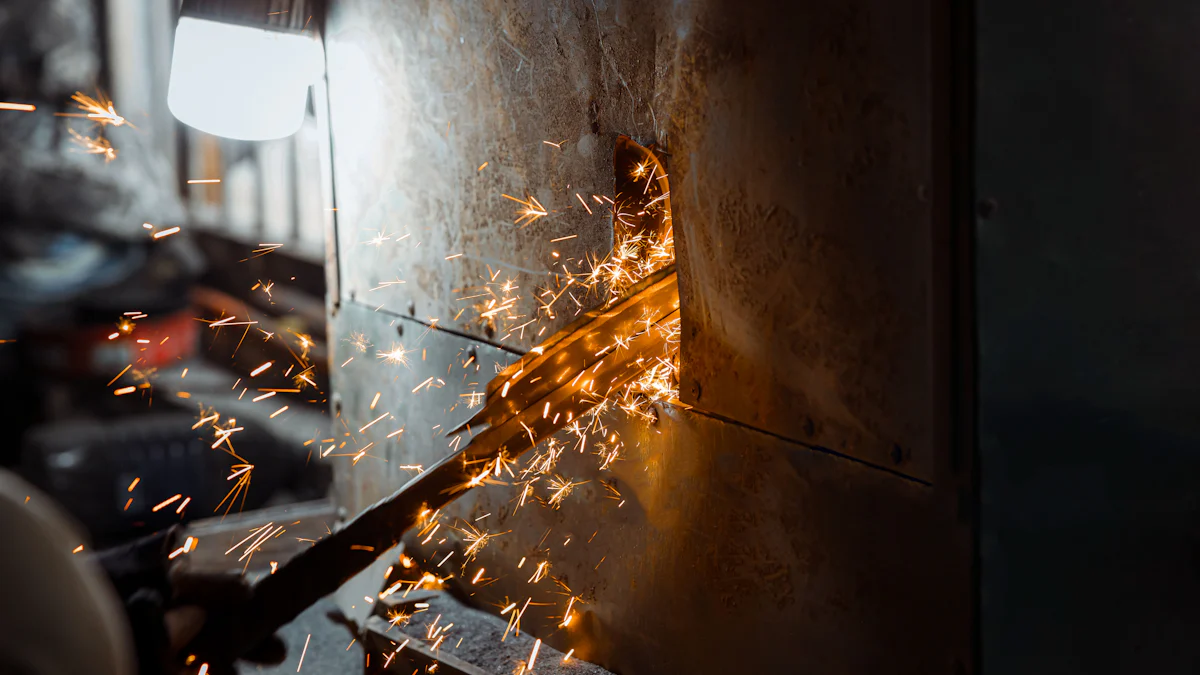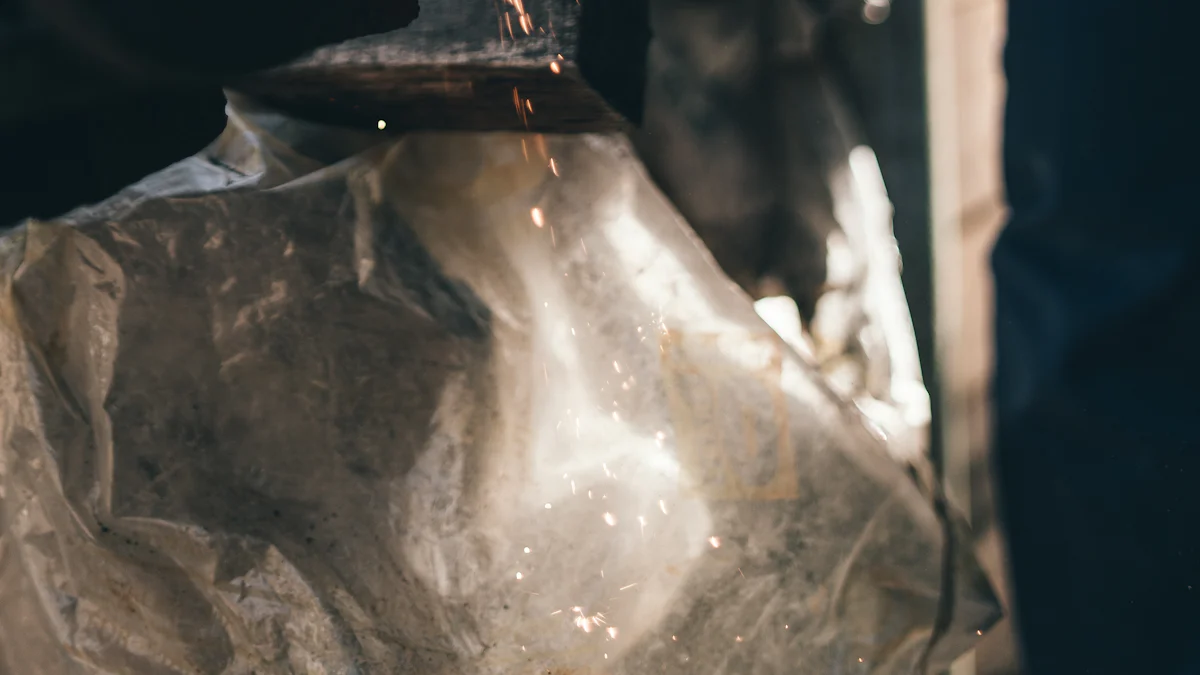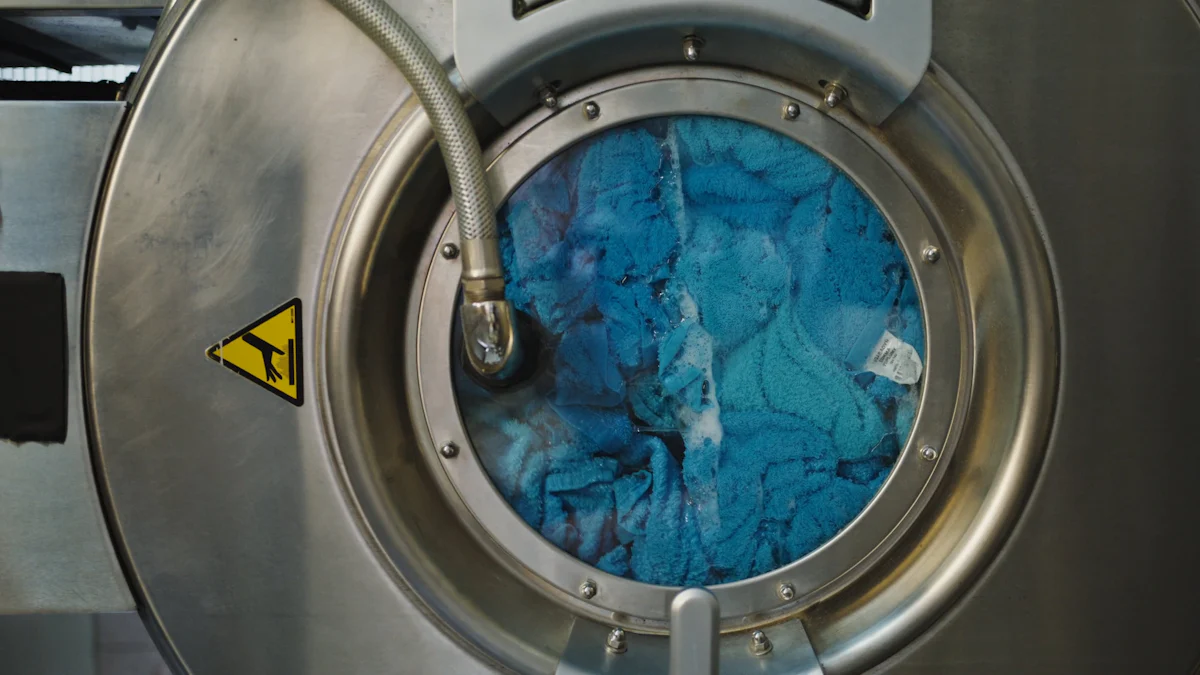Chemical Surface Treatment Processes for Cleaning, Degreasing, and Pickling Metals

Chemical surface treatment plays a vital role in preparing and protecting metal surfaces. You can use these treatments to enhance corrosion resistance, improve coating adhesion, and increase durability. For example, they shield metals from air, moisture, and chemicals, extending their lifespan. Cleaning, degreasing, and pickling are essential steps in these processes. They remove contaminants like rust, grease, and dirt, ensuring the metal performs reliably.
These surface treatment methods find applications across industries. From automotive to aerospace, they prepare metals for heavy-duty tasks or delicate precision work. By choosing the right types of surface treatment methods, you can ensure metals meet the demands of their intended use.
Cleaning Processes in Chemical Surface Treatment

Alkaline Cleaning
How alkaline solutions remove dirt, grease, and oils.
Alkaline cleaning is one of the most common surface treatment methods for removing organic contaminants like grease, oil, and dirt. It uses an alkaline solution containing various components that work together to clean metal surfaces effectively. For example, alkaline builders provide the necessary alkalinity to break down fats and oils through a process called saponification. Wetting agents reduce surface tension, allowing the solution to penetrate and displace contaminants. Other components, such as sequestering agents, prevent metal ions from interfering with the cleaning process, while emulsifiers suspend contaminants in the solution for easy rinsing.
This method ensures thorough cleaning, making it an essential step in chemical surface treatment. By removing contaminants, it prepares the metal for subsequent processes like coating or plating.
Applications in automotive and aerospace industries.
You’ll find alkaline cleaning widely used in industries like automotive and aerospace. In these sectors, it ensures that metal components are free from grease and dirt, which is critical for achieving strong adhesion during painting or coating. For example, car parts and aircraft components often undergo alkaline cleaning to meet stringent quality standards.
Solvent Cleaning
Use of organic solvents for cleaning delicate surfaces.
Solvent cleaning relies on organic solvents to dissolve oils, grease, and other contaminants that water-based solutions cannot remove. This method is particularly effective for cleaning delicate surfaces, as it avoids the use of abrasive materials. Solvent cleaning also eliminates the need for rinsing and drying, reducing the overall cleaning cycle time.
Benefits for electronics and precision equipment.
This method is ideal for cleaning electronics and precision equipment. It removes fluxes, oils, and other residues without damaging sensitive components. Additionally, it requires minimal maintenance and occupies less space, making it a practical choice for industries where precision and efficiency are paramount.
Ultrasonic Cleaning
Combining chemical solutions with ultrasonic waves.
Ultrasonic cleaning combines chemical solutions with high-frequency sound waves to remove contaminants from metal surfaces. The ultrasonic waves create microscopic bubbles in the cleaning solution, which collapse and generate a scrubbing action. This process effectively cleans hard-to-reach areas, making it superior to manual scrubbing.
Applications in medical and industrial tools.
This method is widely used in industries like medical, pharmaceutical, and industrial manufacturing. For example, it cleans surgical instruments, pharmaceutical equipment, and industrial machinery with precision. Ultrasonic cleaning ensures consistent results, making it a reliable choice for applications requiring high cleanliness standards.
Degreasing Processes and Their Applications
Vapour Degreasing
How vapourized solvents clean metal surfaces.
Vapour degreasing uses heated solvents to clean metal surfaces effectively. The process involves boiling a solvent to produce vapor, which condenses on the cooler metal surface. This condensation dissolves contaminants like grease and oil, leaving the surface clean. The method ensures uniform cleaning by enveloping the entire part in solvent vapour, even reaching intricate areas that other methods might miss.
Applications in manufacturing and electronics.
You’ll find vapour degreasing widely used in manufacturing and electronics industries. Automated systems ensure consistent cleaning, reducing human error and maintaining high standards. This method also minimizes solvent waste through closed-loop processes, making it environmentally friendly. Advanced designs, such as refrigeration coils, reduce emissions and protect workers from harmful fumes. These features make vapour degreasing a reliable choice for industries requiring precision and safety.
Aqueous Degreasing
Use of water-based solutions for eco-friendly cleaning.
Aqueous degreasing uses water-based solutions combined with detergents or surfactants to remove contaminants. This method is an eco-friendly alternative to solvent-based cleaning. It reduces air emissions and solvent waste, as demonstrated by Lockheed Martin, which replaced vapor degreasers with aqueous systems. This change reduced solvent use to less than 2 tons per year and saved nearly $500,000 in procurement costs.
Benefits for large-scale industrial operations.
Aqueous degreasing is ideal for large-scale operations due to its cost-effectiveness and safety. The cleaning agents are safer for workers to handle, with lower toxicity levels compared to solvents. This promotes workplace safety and reduces health risks. Industries like automotive and aerospace benefit from its ability to clean large volumes of components efficiently.
Emulsion Degreasing
Combining water and oil-based solutions for effective cleaning.
Emulsion degreasing combines water and oil-based solutions to remove stubborn contaminants. The oil-based component dissolves grease and oils, while the water-based component helps rinse away residues. This dual-action approach ensures thorough cleaning, even for heavily soiled surfaces.
Applications in heavy machinery maintenance.
This method is particularly useful in maintaining heavy machinery. It effectively removes grease, oil, and dirt from large, complex equipment. Industries like construction and mining rely on emulsion degreasing to keep their machinery in optimal condition. Its ability to handle tough cleaning tasks makes it a preferred choice for heavy-duty applications.
Pickling Processes for Metal Preparation

Acid Pickling
Removing rust, scale, and oxides with acidic solutions.
Acid pickling is a widely used chemical surface treatment for removing rust, scale, and oxides from metal surfaces. During this process, you immerse the metal in an acid bath, where the acid reacts with impurities, dissolving them and leaving a clean surface. The reaction begins when the acid penetrates cracks and pores in the oxide layers, dissolving the easily soluble parts. This destabilizes the harder layers, which then detach from the metal. Once the acid reaches the base metal, it releases hydrogen, further aiding in oxide removal.
Common acids used include hydrochloric acid, which acts quickly, and sulfuric acid, known for its cost-effectiveness. For specialized applications, phosphoric and hydrofluoric acids provide precise control. You can choose between batch pickling for small parts, continuous pickling for large quantities, or spray pickling for complex geometries.
Applications in steel production and fabrication.
Steel production and fabrication heavily rely on acid pickling. It ensures clean surfaces for processes like welding, coating, or galvanizing. Technological advancements, such as regenerative systems, now recover acid and reduce environmental impact, making this method more sustainable.
Electrolytic Pickling
Using electric currents to enhance pickling efficiency.
Electrolytic pickling uses electric currents to improve the efficiency of the pickling process. The current accelerates the removal of oxides and impurities, ensuring uniform cleaning. This method is particularly effective for high-precision components, as it removes material at a microscopic level.
Benefits for high-precision metal components.
You’ll find electrolytic pickling essential for industries like aerospace, automotive, and medical devices. It ensures consistent material removal, which is critical for parts where fit and function are paramount. This precision also enhances oxidation resistance, extending the lifespan of the components.
Neutral Pickling
Gentler pickling methods for sensitive metals.
Neutral pickling offers a milder alternative for cleaning sensitive metals like aluminum and stainless steel. Instead of strong acids, this method uses less aggressive solutions to remove light oxides and impurities without damaging the base metal.
Applications in aluminum and stainless steel industries.
This method is ideal for industries working with aluminum and stainless steel. It prepares these metals for further surface treatment methods, such as anodizing or coating, while preserving their structural integrity.
Advanced Chemical Surface Treatments and Their Applications
Electroplating
Forming a thin metallic coating for protection and appearance.
Electroplating is a widely used surface treatment method that enhances both the appearance and functionality of metals. This process uses electric currents in an electrolyte solution to deposit a thin layer of metal onto a workpiece. The positively charged metal ions bond with the negatively charged surface, creating a uniform coating. This layer improves the material’s durability, wear resistance, and chemical resistance. It also forms a protective barrier against environmental factors, extending the lifespan of components.
Electroplating allows you to combine the beneficial properties of different metals. For example, you can plate a steel component with chromium to improve abrasion resistance or with gold to enhance conductivity. This versatility makes electroplating an essential technique in modern manufacturing.
Applications in automotive and decorative industries.
Electroplating plays a crucial role in the automotive and decorative industries. In automotive applications, it protects car parts from corrosion and wear, ensuring long-term performance. Decorative plating, such as gold or nickel, enhances the aesthetic appeal of jewelry, watches, and household fixtures. This process combines functionality with visual appeal, making it a preferred choice for various industries.
Anodizing
Increasing oxide layer thickness for corrosion resistance.
Anodizing is a chemical surface treatment that increases the thickness of the natural oxide layer on metals like aluminum. This process enhances corrosion resistance, durability, and abrasion resistance. The anodized layer also improves chemical resistance, protecting the metal from harsh environments.
Benefits for aerospace and architectural components.
Anodizing offers several benefits for aerospace and architectural components. It enhances durability, reducing the risk of scratches and dents. The oxide layer provides excellent corrosion resistance, preventing moisture and chemicals from damaging the metal. Additionally, anodized surfaces improve paint adhesion and adhesive bonding, ensuring a long-lasting finish. The process is environmentally sustainable, making it a responsible choice for modern industries.
Benefit | Description |
|---|---|
Enhanced Durability | Reduces the risk of scratches, dents, and wear. |
Increased Corrosion Resistance | Prevents moisture and corrosive elements from penetrating the metal. |
Excellent Electrical Insulation | Improves electrical insulation properties for reliable performance. |
Better Paint Adhesion | Allows for firm paint adhesion, resulting in a longer-lasting finish. |
Improved Adhesive Bonding | Promotes strong adhesion, enhancing structural integrity. |
Low Maintenance | Requires minimal upkeep due to its protective layer. |
Environmental Sustainability | Anodizing is environmentally friendly and sustainable. |
Chemical Conversion Coatings
Enhancing corrosion resistance and paint adhesion.
Chemical conversion coatings chemically alter the surface of metals to improve corrosion resistance and paint adhesion. These coatings form a protective layer that shields the metal from rust and enhances its durability. Zinc phosphate priming, for instance, provides mild corrosion resistance while improving paint performance.
Applications in automotive and construction industries.
Chemical conversion coatings are vital in automotive and construction industries. In automotive applications, they protect car bodies and components from rust while ensuring strong paint adhesion. In construction, these coatings prevent rust on structural components and improve the durability of painted surfaces.
Industry | Application Description |
|---|---|
Automotive | Protects car bodies and components from rust and enhances paint adhesion. |
Construction | Used on structural components to prevent rust and improve paint performance. |
Chemical Etching
Removing surface layers for cleaning or preparation.
Chemical etching is a precise surface treatment method that removes unwanted layers from metals or other materials. This process uses chemical solutions to dissolve specific areas of the material, leaving behind a clean and prepared surface. Unlike mechanical methods, chemical etching is a non-contact process. This eliminates the risk of mechanical stress or damage to the substrate, making it ideal for delicate or intricate components.
You can achieve highly accurate results with chemical etching. The process creates complex patterns and fine details without degrading the material. It also ensures that every part remains perfectly flat, which is essential for certain applications. Additionally, the method is cost-effective. Digital photo tooling, used in chemical etching, is much less expensive than conventional tooling methods. You can even arrange multiple designs on the same tooling, reducing costs and speeding up prototyping.
Applications in electronics and precision manufacturing.
Chemical etching plays a crucial role in industries like electronics and precision manufacturing. In electronics, it produces intricate designs required for modern devices. For example, it creates complex circuit patterns and micro-components with high precision. The process works well with various materials, offering versatility for different applications.
In precision manufacturing, chemical etching ensures consistent quality. It produces features with high accuracy, which is vital for aerospace and medical industries. The non-contact nature of the process prevents mechanical damage, preserving the integrity of delicate parts. Additionally, the ability to automate chemical etching makes it cost-effective for large-scale production.
Key advantages of chemical etching include:
Cost and lead-time efficiency, as complexity does not affect production time.
Finer detail production with minimal material degradation.
Flatness assurance, ensuring every part meets strict standards.
This method combines precision, versatility, and cost-effectiveness, making it indispensable for modern manufacturing.
💡 Tip: Chemical etching is often paired with plasma treatments to further enhance surface preparation and adhesion.
Benefits of Chemical Surface Treatment Processes
Improved Surface Quality
Enhancing adhesion for coatings and paints.
Chemical surface treatment improves the bond between metal surfaces and coatings like paint or adhesives. By removing contaminants and creating a clean, reactive surface, these treatments ensure coatings adhere firmly. This strong adhesion prevents peeling or flaking, which is critical in industries like automotive and aerospace. For example, plasma treatments can further enhance adhesion by modifying the surface at a molecular level, ensuring long-lasting performance.
Preventing corrosion and extending metal lifespan.
Surface treatments play a vital role in protecting metals from corrosion. They create a barrier that shields the material from air, moisture, and chemicals. This protection extends the lifespan of components, reducing the need for frequent replacements. The table below highlights the key benefits of improved surface quality:
Benefit | Description |
|---|---|
Corrosion Resistance | Protects materials from degradation caused by exposure to air, moisture, or chemicals. |
Enhances the bond between the surface and paint, adhesives, or other coatings. | |
Increased Durability | Enhances the hardness and wear resistance of materials. |
Enhanced Aesthetic Appeal | Provides a more polished, uniform appearance for materials used in consumer-facing applications. |
Cost-Effectiveness
Reducing material waste and rework.
Chemical surface treatment minimizes material waste by ensuring components meet quality standards the first time. Processes like plasma cleaning remove contaminants effectively, reducing the likelihood of defects. This precision lowers the need for rework, saving time and resources.
Lowering maintenance costs in industrial applications.
By enhancing durability and corrosion resistance, surface treatments reduce the frequency of maintenance. For example, treated metals in construction or manufacturing environments resist wear and tear, lowering repair costs. This cost-effectiveness makes these treatments a smart investment for large-scale operations.
Environmental Considerations
Eco-friendly alternatives in cleaning and degreasing.
Many modern surface treatments now use eco-friendly methods. For instance, plasma treatments eliminate the need for harmful solvents, reducing volatile organic compound (VOC) emissions. Biodegradable cleaning agents and phosphorus-free pretreatments further minimize environmental impact.
Compliance with industry regulations.
Eco-friendly surface treatments help you meet strict environmental regulations. Processes like low-temperature cleaning reduce energy consumption, while chemical recycling minimizes waste. The table below outlines the environmental benefits:
Benefit | Description |
|---|---|
Reduced Environmental Footprint | Minimal VOC content helps meet environmental regulations and contributes to cleaner air. |
Improved Health and Safety | Eliminating harmful solvents creates a safer working environment for employees. |
Biodegradable Cleaning Agents | Replacing toxic cleaning chemicals with biodegradable options minimizes environmental impact. |
Phosphorus-Free Pretreatment | Effective surface preparation without contributing to water pollution and eutrophication. |
Energy-Efficient Processes | Low-temperature cleaning reduces energy consumption and greenhouse gas emissions. |
Waste Management Practices | Chemical recycling and water recycling minimize waste generation and resource consumption. |
🌱 Tip: Switching to eco-friendly surface treatments not only protects the environment but also enhances workplace safety and reduces long-term costs.
Chemical surface treatment processes play a crucial role in preparing and protecting metal surfaces. Cleaning, degreasing, and pickling remove contaminants, ensuring metals are ready for further applications like coating or plating. Advanced treatments, such as electroplating and anodizing, enhance durability, corrosion resistance, and aesthetic appeal.
Choosing the right surface treatment depends on the material and its intended use. For example, neutral pickling works best for sensitive metals, while vapor degreasing suits precision components. Selecting the proper method ensures optimal performance and longevity.
Industries like aerospace, automotive, and construction benefit significantly from these treatments. The table below highlights specific advantages for various sectors:
Industry | Advantages |
|---|---|
Aerospace | Enhances durability of components to withstand extreme temperatures and environmental conditions. |
Automotive | Improves corrosion resistance and provides a durable base for paint. |
Construction | Treated metals resist weathering and wear for structural components. |
Electronics | Ensures longevity and reliability of components in harsh environments. |
Medical and Healthcare | Improves biocompatibility, sterilization, and corrosion resistance for medical devices. |
Oil and Gas | Prevents corrosion and extends service life of pipelines and equipment. |
Furniture and Decorative Coatings | Enhances adhesion, durability, and aesthetic appeal of surfaces. |
Packaging | Improves printability, adhesion, and barrier properties of packaging materials. |
By understanding these processes and their benefits, you can make informed decisions to meet your specific needs.
FAQ
What is the purpose of chemical surface treatments?
Chemical surface treatments prepare metal surfaces for further processes like coating or plating. They remove contaminants, improve corrosion resistance, and enhance durability. These treatments also ensure better adhesion for paints and coatings, making metals more reliable for industrial and commercial applications.
Are chemical surface treatments environmentally friendly?
Many modern treatments use eco-friendly methods. For example, aqueous degreasing and biodegradable cleaning agents reduce environmental impact. Processes like chemical recycling and low-temperature cleaning also minimize waste and energy consumption, helping you comply with environmental regulations.
How do I choose the right surface treatment for my project?
The choice depends on the material and its intended use. For sensitive metals like aluminum, neutral pickling works best. For precision components, vapor degreasing ensures thorough cleaning. Consider the metal type, application, and desired properties when selecting a treatment.
Can chemical surface treatments improve product lifespan?
Yes, these treatments protect metals from corrosion, wear, and environmental damage. By creating a durable barrier, they extend the lifespan of components. For example, anodizing enhances aluminum’s resistance to moisture and chemicals, ensuring long-term performance.
Are chemical surface treatments cost-effective?
Chemical surface treatments reduce material waste and rework, saving time and resources. They also lower maintenance costs by enhancing durability and corrosion resistance. For large-scale operations, these benefits make the treatments a smart investment.
💡 Tip: Always consult with a surface treatment expert to ensure the best results for your specific application.
See Also
Top 10 Surface Finishing Techniques Every Metalworker Should Master
Understanding Sandblasting: Key Concepts and Practical Uses
A Guide to Various Powder Coating Techniques and Applications
Importance of Metal Substrates in Today’s Industrial Applications
Enhancing Diecast Durability Through Effective Electroplating Techniques
About Hunan Puka
Established in 2016 and based in Hunan, China, with a liaison point in Berlin, we are a Tier 2 supplier for the automobile industry. We specialize in the production of customized aluminum die-casting parts designed for machines with a closing force ranging from 280 to 800 tons, with subsequent manufacturing process CNC machining and surface treatment. Our commitment to quality is reflected in our accredited quality management system, certified by ISO9001:2015 and IATF16949:2016 standards.


